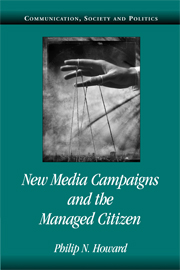Book contents
- Frontmatter
- Contents
- List of Tables and Figures
- Acknowledgments
- Prologue: The Flows of Information in Competitive Politics
- Introduction: The Hypermedia Campaign
- 1 Political Communication and Information Technology
- 2 Producing the Hypermedia Campaign
- 3 Learning Politics from the Hypermedia Campaign
- 4 Organizational Communication in the Hypermedia Campaign
- 5 Managed Citizenship and Information Technology
- Appendix: Method Notes on Studying Information Technology and Political Communication
- Glossary
- References
- Index
- Titles in the series
Introduction: The Hypermedia Campaign
Published online by Cambridge University Press: 15 December 2009
- Frontmatter
- Contents
- List of Tables and Figures
- Acknowledgments
- Prologue: The Flows of Information in Competitive Politics
- Introduction: The Hypermedia Campaign
- 1 Political Communication and Information Technology
- 2 Producing the Hypermedia Campaign
- 3 Learning Politics from the Hypermedia Campaign
- 4 Organizational Communication in the Hypermedia Campaign
- 5 Managed Citizenship and Information Technology
- Appendix: Method Notes on Studying Information Technology and Political Communication
- Glossary
- References
- Index
- Titles in the series
Summary
After the 2000 election, exit polls revealed that a third of the electorate had used the internet to learn about the campaigns. After the 2004 election, surveys revealed that over half the electorate had gone online to get news or information about the campaigns. Yet the growing number of citizens who use the internet in their political lives may not realize that they are being fed highly personalized information. In the weeks before the 2000 election, when “Elaine” – a conservative, middle-aged voter living in Clemson, South Carolina – logged onto her favorite Republican Web site, she saw headlines about the commitment of Republican candidates to the Second Amendment right to bear arms and pro-life arguments against abortion. When “Lois,” a middle-aged Republican voter living in Manhattan, logged onto the same site, she was never shown those headlines. Designers of the Republican Web site knew that even though Lois was conservative on many issues, their statistical models suggested she would support some form of gun control and a woman's right to choose. The Webmasters were right, but neither Elaine nor Lois suspected that, as members of the same political party, they were receiving significantly different political information during the campaign season. In fact, they assumed the opposite – that everyone in their political party received the same content.
Information technologies have played a role in campaign organization of the major parties since the 1970s, but it is only over the last decade that adopting new technologies also became an occasion for organizational restructuring within political parties and campaigns.
- Type
- Chapter
- Information
- New Media Campaigns and the Managed Citizen , pp. 1 - 32Publisher: Cambridge University PressPrint publication year: 2005



